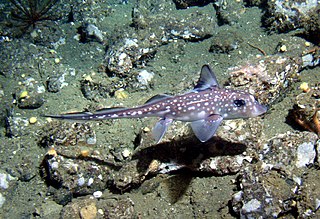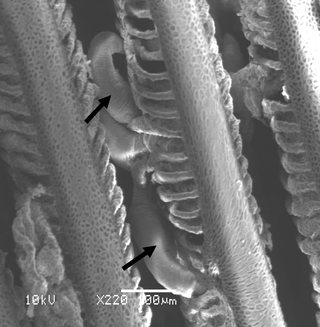
Chimaeras are cartilaginous fish in the order Chimaeriformes, known informally as ghost sharks, rat fish, spookfish, or rabbit fish; the last three names are not to be confused with rattails, Opisthoproctidae, or Siganidae, respectively.
Friedrich Andreas Sigismund Leuckart was a German doctor and naturalist.

Polyopisthocotylea is a subclass of parasitic flatworms in the class Monogenea.

Pseudorhabdosynochus is a genus of monopisthocotylean monogeneans, included in the family Diplectanidae. The type-species of the genus is Pseudorhabdosynochus epinepheli .

Pseudorhabdosynochus epinepheli is a diplectanid monogenean parasitic on the gills of species of groupers. It is the type species of the genus Pseudorhabdosynochus Yamaguti, 1958.
Hexabothriidae is a family of monogenean parasites. The family name was proposed by Emmett W. Price in 1942. The family includes 14-16 genera according to authors and about 60 species; all are parasitic on the gills of chondrichthyan fishes.

Pseudorhabdosynochus oliveri is a diplectanid monogenean parasitic on the gills of the dusky grouper.

Chimaericolidae is a family of monogenean parasites. The family was named by Brinkmann in 1942.

Chimaericola leptogaster is a species of polyopisthocotylean monogenean in the family Chimaericolidae. It is ectoparasitic on the gills of the chimaera Chimaera monstrosa.

Leptogaster is a genus of robber flies in the family Asilidae. There are at least 260 described species in Leptogaster.

Ancyrocephalidae is a family of monogenean flatworms. The family is considered as a "temporary name" in WorMS but includes a large number of genera and species.
Aethycteron is a genus of monogeneans belonging to the family Ancyrocephalidae. All members of the genus are parasitic on fish. The generic name is derived from the Greek aithycteros, meaning "darter", due to the fact that its members have been found infecting darters.
Anchoradiscus is a genus of monogeneans belonging to the family Ancyrocephalidae. All members of the genus are parasitic on North American centrachid fish.
Anchoradiscoides is a genus of monogeneans belonging to the family Ancyrocephalidae. All members of the genus are parasitic on North American centrachid fish.
Pseudorhabdosynochus bocquetae is a diplectanid monogenean parasitic on the gills of groupers. It has been described in 1984 by Guy Oliver and Ilan Paperna. The species was first described as Cycloplectanum bocquetae and transferred to the genus Pseudorhabdosynochus by Delane C. Kritsky and Mary Beverley-Burton in 1986.
Pseudorhabdosynochus caballeroi is a diplectanid monogenean parasitic on the gills of fish. It has been described in 1984 by Guy Oliver. The name of the species honours Professor Eduardo Caballero y Caballero, a Mexican parasitologist.
Pseudorhabdosynochus cupatus is a species of diplectanid monogenean parasitic on the gills of groupers.

Pseudorhabdosynochus lantauensis is a diplectanid monogenean parasitic on the gills of the longtooth grouper, Epinephelus bruneus. It was described in 1981 as Cycloplectanum lantauensis and later transferred to the genus Pseudorhabdosynochus by Kritsky & Beverley-Burton in 1986.
Pseudorhabdosynochus serrani is a species of diplectanid monogenean parasitic on the gills of a fish. It was described in 1953 by Satyu Yamaguti as Diplectanum serrani and later transferred to the genus Pseudorhabdosynochus. The species has been redescribed in 2005.
Pseudorhabdosynochus vagampullum is a species of diplectanid monogenean parasitic on the gills of a grouper. It was described in 1969, from eight specimens, under the name Diplectanum vagampullum and transferred to the genus Pseudorhabdosynochus in 1986. The species has been redescribed several times.









